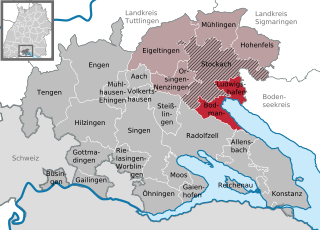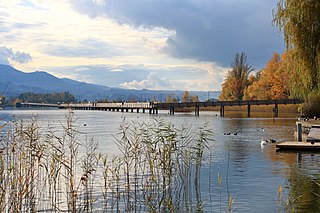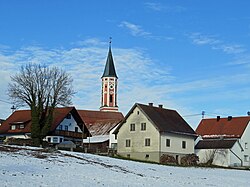
Bad Schussenried is a spa town in Upper Swabia in the district of Biberach, Baden-Württemberg, Germany.

Attersee am Attersee is a village on the western shore of Attersee lake in the Austrian state of Upper Austria.

Mondsee is a town in the Vöcklabruck district in the Austrian state of Upper Austria located on the shore of the lake Mondsee. The town is home to the medieval Mondsee Abbey, whose cloister church was used for the site of the wedding in The Sound of Music.

Feldafing is a municipality in Starnberg district, Bavaria, Germany, and is located on the west shore of Lake Starnberg, southwest of Munich.

Alleshausen is a municipality in the district of Biberach in Baden-Württemberg in Germany.

Sipplingen is a municipality in the district of Bodensee in Baden-Württemberg in Germany.

Allensbach is a municipality in the district of Konstanz in Baden-Württemberg in Germany.

Bodman-Ludwigshafen is a municipality in the district of Konstanz in Baden-Württemberg in Germany, located on the most western shore of Lake Überlingen, the north-western part of the Upper Lake of Lake Constance. The municipality consist of the two separate villages Bodman and Ludwigshafen on each side of Lake Überlingen. In 1975, the former municipalities Ludwigshafen am Bodensee and Bodman united to the current administrative situation. The German term for Lake Constance, Bodensee, derives from Bodman.

Gaienhofen is a municipality in the district of Konstanz in Baden-Württemberg in Germany. It is located at the border with Switzerland.

Öhningen is a municipality on the western edge of Lake Constance where it forms the border between Switzerland and the district of Konstanz in Baden-Württemberg in Germany.

Wolpertswende is a town in the district of Ravensburg in Baden-Württemberg in Germany.

Geltendorf is a municipality in the district of Landsberg in Bavaria, Germany.

Steingaden is a town and municipality in the Weilheim-Schongau district of Upper Bavaria, Germany. It is the site of the 12th-century Steingaden Abbey and the Wies Church, a UNESCO World Heritage Site.

Enge is a quarter in District 2 of Zürich, Switzerland.

Holzbrücke Rapperswil-Hurden is a wooden pedestrian bridge between the city of Rapperswil and the village of Hurden crossing the upper Lake Zürich (Obersee) in Switzerland. The prehistoric timber piles discovered to the west of the Seedamm date back to 1523 BC. The island settlement Technikum is a prehistoric pile-dwelling settlement which is part of the UNESCO World Heritage Site Prehistoric Pile dwellings around the Alps. The first wooden footbridge led across Lake Zürich, followed by several reconstructions at least until the late 2nd century AD when the Roman Empire built a 6 metres (20 ft) wide wooden bridge. Between 1358 and 1360, Rudolf IV, Duke of Austria, built a 'new' wooden bridge across the lake that was used until 1878. On 6 April 2001, the reconstructed wooden footbridge was opened, being the longest wooden bridge in Switzerland.

Prehistoric pile dwellings around the Alps are a series of prehistoric pile dwelling settlements in and around the Alps built from about 5000 to 500 BC on the edges of lakes, rivers or wetlands. In 2011, 111 sites located variously in Switzerland (56), Italy (19), Germany (18), France (11), Austria (5) and Slovenia (2) were added to the UNESCO World Heritage Site list. In Slovenia, these were the first World Heritage Sites to be listed for their cultural value.

Grossner Hafner is one of the 111 serial sites of the UNESCO World Heritage Site Prehistoric pile dwellings around the Alps, of which are 56 located in Switzerland.

Prehistoric pile dwellings around Lake Zurich comprises 11 – or 10% of all European pile dwelling sites – of a total of 56 prehistoric pile dwellings around the Alps in Switzerland, that are located around Lake Zurich in the cantons of Schwyz, St. Gallen and Zürich.

Freienbach–Hurden Rosshorn is one of the 111 serial sites of the UNESCO World Heritage Site Prehistoric pile dwellings around the Alps, of which are 56 located in Switzerland.

Erlenbach–Winkel is one of the 111 serial sites of the UNESCO World Heritage Site Prehistoric pile dwellings around the Alps, of which are 56 located in Switzerland.

























